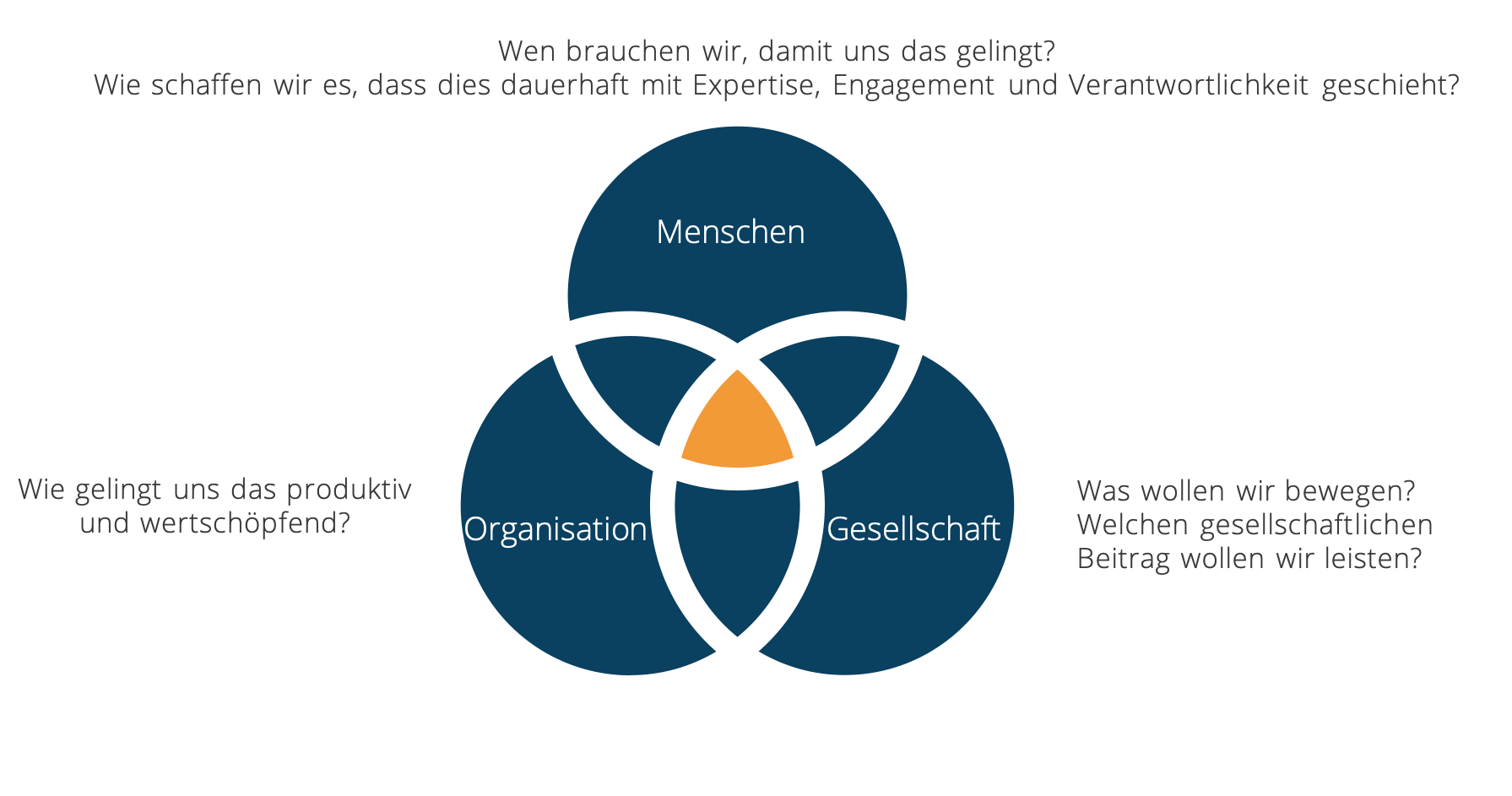Corporate identity - key element for employee retention
Let's assume you work for a company whose service or product you hardly identify with. You hardly notice your boss - even less now in the home office. And the nice colleagues, the chat in the coffee kitchen, the door-to-door talks in the office or the joint lunch have not existed for months. With how much heart and soul will you do your job permanently?
Employees and managers put their heart and soul into the completion of their tasks and the further development of the company when they identify with the company. Whether they do so depends above all on the corporate identity, i.e. the cultural identity of the company. Since I see time and again that corporate identity is reduced to the logo and the design of business cards, brochures and the website, I would like to clearly outline here once again what the central elements of corporate identity are.
A strong corporate identity is determined by:
- an attractive company purpose
- the target clarity
- a strong culture of trust
- a appreciative management culture: This also includes the feedback culture, the Error- and Learning culture and the Culture of potential development
- a trustworthy and transparent Communication culture
All these elements determine how strongly employees and managers identify with the company and with how much commitment they carry out their tasks - regardless of where they do so from.
If the corporate identity is weak, the emotional distance will increase with the increasing spatial distance. Identification with the company will erode. Quality, cost awareness and productivity will decline. Internal resignations will increase and possibly lead to actual resignations. The competitiveness of the company will be damaged.
So when companies think about the future ways of working for their company after the pandemic, it is imperative to examine the strength of the corporate identity.
Let's look at the individual components of corporate identity in detail:
Elements of corporate identity
Attractive Purpose
The purpose of a company expresses what the company stands for. It can be defined through three questions:
- What do we want to leave behind for posterity?
- What problem do we want to solve?
- What social contribution do we want to make with our business model?
The Kienbaum, a management consultancy, conducted the "Purpose study" shows that This is because the majority of employers (60%) cannot define the purpose of their company. ad hoc can name. This is thought-provoking, as a purpose that inspires and excites is always a central element of identity creation and a strong employer brand.
Recommendation for action: Sharpen the purpose, communicate it clearly or develop it together with the employees.
Elements of corporate identity
Clarity of purpose and objectives
Clear goals across all management and staff levels are the be-all and end-all for good competitiveness. This becomes significantly more relevant with mobile forms of work such as the home office. Goals should be SMART (specific, medible, attractive or aaccepted, realistic and termined) and be transparent. Everyone should identify with the corporate goals, divisional and team goals as well as their own goals and know what concrete contribution they are making to achieving the goals. Conflicting goals can be avoided if the goal-setting process is carried out jointly, if goals at the different levels build on each other and are openly communicated.
Recommendation for action: Develop SMART goals in dialogue, communicate transparently
Elements of corporate identity
Strong culture of trust
Trust is a key element of sustainable competitiveness. A strong culture of trust within the company not only ensures an honest feedback culture, it also contributes significantly to a constructive Error- and Conflict culture and is thus the basis for innovation, permanent learning and further development.
A strong culture of trust in a company demands self-efficacy from employees and managers, their willingness to experiment, as well as entrepreneurial thinking and action. This means that a trusting relationship always radiates to the market, i.e. to customers, service providers and cooperation partners.
However, trust is not static. It comes into being, is subject to constant change, and can grow or decline as a result. Therefore, it is also of central importance for companies to develop their own togetherness. over and over again through observation and exchange and to work on it. "How much do I trust you? How much do you trust me? How can we tell that we trust each other?" are the central questions to be asked and discussed.
Recommendation for action: At regular intervals, carry out a Trust analysis carry out.
Harmony as a stumbling block
When we conduct a trust analysis in companies, we notice that trust is very often confused with harmony. If the need for harmony is very strong in companies, this can even permanently damage the basis of trust, because conflicts are no longer addressed and thus there is no chance to resolve them.
Elements of corporate identity
Appreciative leadership culture
Leadership is necessary to bring the purpose to life and to achieve the goals set. The understanding of leadership has been in a state of flux for several years. "Agile leadership", "digital leadership", "purpose-driven leadership" - to name a few of the buzzwords in the media. In my view, sustainable leadership is always about the same thing. It is about bringing three dimensions into harmony: Market, organisation and people:

The key question in times of home office is: How do we make productive and value-adding work happen permanently with expertise, commitment and accountability?
Ensuring this means living an understanding of leadership that focuses on the development of the potential of individuals and entire teams. This in turn requires above all a resilient culture of trust, clarity of purpose, a distinctive systemic thinking, regular constructive feedback, honest appreciation, a constructive culture of dispute and conflict. It requires freedom for the individual and increasing self-organisation of the teams. In order for the whole to remain more than the sum of its parts, transparent and trusting communication is indispensable.
Recommendation: Question and, if necessary, redefine the understanding of leadership, operationalise the newly defined understanding of leadership so that it is also lived in everyday life.
Elements of corporate identity
Trusting and transparent communication culture
Communication is both an expression and an element of corporate identity. The aim of communication in companies should always be to strengthen the basis of trust and to create transparency about goals, results, roles, responsibilities, processes, decisions and much more.
Who needs what information at what point in time in order to be able to continue to work with commitment, responsibility and expertise - in other words, with head and heart to achieve the goals?
What is the best way to convey this information? What needs to be written, what needs to be spoken? In which circle? In what frequency?
Since the home office eliminates many informal opportunities for exchange, such as the coffee kitchen, the canteen, the hallway or desk-to-desk conversations, companies are required to create real meeting spaces in addition to virtual platforms.
Impulses for the future
Real meeting spaces rethought
How this can look after the end of the pandemic is outlined by Susanne Vogel, graduate engineer for architecture and Research assistant at the Chair of Representation at the TU Dresden. "There are many potential meeting spaces. The important thing is that they fit the culture of the company and pick up on or even underline values of the company." In addition to classic company-internal common rooms, the trend already exists, "to have work-related encounters also take place in cafés, restaurants or in culturally charged spaces, such as museums, theatres or architectural monuments. This development will certainly continue." says Susanne Vogel.
What is important here is the quality of the space and the reference that the company makes to this meeting space. "Why do we meet here? What common values connect us to this place?" are two central questions that need to be made transparent.
Whether these new forms of encounter are accepted also depends on this, "where the company comes from and what employees and clients are already used to. Companies from the creative or consulting industries, which often do not need more than head, heart, laptop, paper and pen for daily exchange or work, may feel more comfortable in open, culturally connoted spaces than employees from conventional industries whose work behaviour is less situational and who are used to established work structures and also need them for productive work."
In general, Susanne Vogel recommends that companies whose employees want a broad home office arrangement even after the end of the pandemic ask what these employees are looking for in a home office:
- Would you like to save commuting and travel time by working from home?
- Can children be better cared for?
- Can employees concentrate better at home?
- Are conflicts reduced by working from home?
- Do employees feel significantly more comfortable in the spatial environment of their own home? And what exactly are the feel-good factors?
- Is working from home a way to avoid colleagues or superiors?
- Does the more flexible work arrangement through the home office enable employees to better pursue private interests and needs such as physical exercise/sport, healthy eating, artistic expression as well as social engagement, such as voluntary work, and thus be more fulfilled and satisfied in the long term?
On the one hand, the answers to these questions provide information about which elements of corporate identity are in need of improvement, and on the other hand, they give impulses as to which requirements places of encounter should fulfil. "For some companies, a rented co-working space in the suburbs and catchment area of a big city is the solution to enable a real meeting of a small group of colleagues and to shorten the commute for them. For others, it's more beautifully designed offices with a free seating concept to sit close to colleagues with whom you work a lot and a high level of communicative interaction increases work efficiency. Still other companies may join forces with cooperation partners in the spatial use of existing space and open up their previously "closed" property to other users with whom they have a lot to do anyway. Others are reorganising their internal meeting spaces to make them larger and more suitable for their needs. In return, workspaces become quieter and allow for better concentration."
In short: everything is possible. What is important is that companies are clear about what should be made possible through encounter and how this encounter should take place so that as many employees as possible participate and the associated goal is achieved.
Conclusion
A strong corporate identity is increasingly becoming a competitive factor for companies
Corporate identity, i.e. what makes a company tick, is becoming increasingly important as the identity created by office space dwindles. Therefore, companies are challenged even more than before to create an identification through purpose, appreciation, leadership culture, trust, team spirit and creative possibilities of the individual that goes beyond the classic "brand consciousness" and is oriented in its creative will and mission towards social and global political aspects.t. Therefore, physical meeting spaces also need to be rethought and balanced with the needs and life phases of the employees. It is time for this!
Did you find this article helpful?



